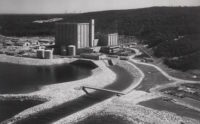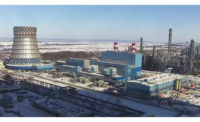Nearing completion in Texas, a 50-MW power plant will demonstrate a first-of-a-kind natural-gas power system. Its developer claims the system, which uses supercritical carbon-dioxide working fluid, will produce low-cost electricity with zero atmospheric emissions. With the plant 90% complete, developers already are pushing ahead with plans for a 295-MW commercial facility, whose technology they expect to be validated.
Net Power LLC, a collaboration of Exelon Generation, CB&I and 8 Rivers Capital, is building the plant in La Porte, near Houston, to demonstrate the ability of its Allam Cycle operation to drive a custom-built Toshiba combustion turbine. Net Power says the operation eliminates atmospheric emissions without requiring costly, inefficient carbon-capture equipment and produces pipeline-quality CO2 for sequestration or industrial use. The $140-million program is funded by cash and in-kind contributions from Exelon and CB&I for demo plant design and construction, technology advancement, testing, operations and product development. 8 Rivers is the technology developer, Exelon provides operations and CB&I is EPC contractor. Net Power spokesman Walker Dimmig says the plant is set to operate this year.
Net Power designed a 300-MW facility which was completed around 2013 and used to scale down to the 50-MW demonstration plant.
Dimmig says the team has taken an unusual approach to development. Rather than design a subscale demonstration plant that might not scale up to the commercial product, Net Power designed a 300-MW facility through a pre-FEED (front-end engineering design), which was completed around 2013 and used to scale down to the 50-MW demonstration plant, he notes. That approach reduces risk that the small plant, if successful, might not scale up. “We don’t care about having a small test facility. We care about having a commercial product as soon as possible,” Dimmig says. “We would rather spend more money to get a demonstration plant that is directly applicable to that commercial product.”
Net Power will generate its own carbon dioxide by burning pure oxygen and natural gas with recycled CO2 in a semiclosed cycle. Liquid water condensed from the fluid is fed back to support cooling. The other product, a CO2 stream, will recycle to the combustor, with the excess sent to a pipeline for sequestration or industrial uses, such as enhanced oil recovery.
The Allam Cycle process may help to create a market to trade carbon dioxide. Unregulated emissions are a key climate-change driver, but pollution sources are not incentivized to cut emissions. “Someday, when there is a significant price on carbon, it may be beneficial for operators to use CO2 in ways that keep it out of the atmosphere,” says Curtis Oldenburg, senior scientist at the Lawrence Berkeley National Laboratory. With Chinese scientists, he proposed storing compressed CO2 in a deep saline aquifer and recycling it in a closed loop to generate power. The concept has been proven in global locations, including at a U.S. compressed-air storage plant. Using CO2 instead of air may improve the process. “CO2 is denser than air, so it has more energy density when compressed,” says Oldenburg.
Atmospheric air is the working fluid for the Brayton Cycle, which commercial gas turbines use. The Electric Power Research Institute has done “quite a bit of study on the supercritical CO2 Brayton Cycle,” says Jeff Phillips, a senior research manager, who touts its higher efficiency. CO2 is being used for power generation in other projects, too. The power plant for a proposed South Texas refinery, for example, is being designed to use the refinery’s CO2partly for its working fluid.





Post a comment to this article
Report Abusive Comment